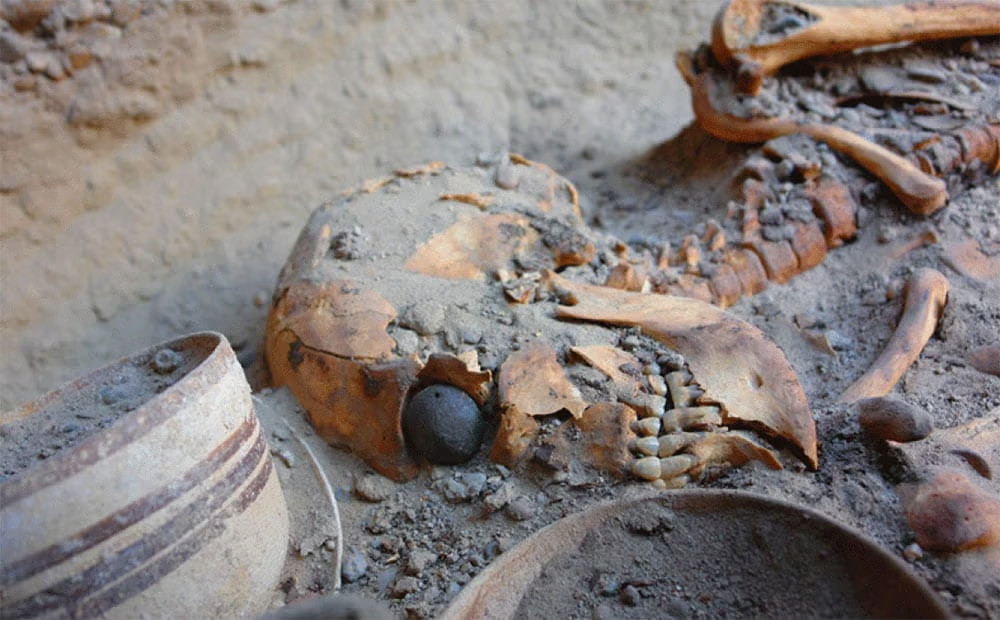Amid the sweltering sands of Iran’s “Burnt City,” archaeologists unearthed an astonishing artifact that would forever alter our understanding of ancient medicine and craftsmanship. This is the captivating story of the world’s oldest artificial eye, a testament to human ingenuity that has endured nearly five millennia.

In 2007, the ruins of Shahr-e Sukhteh, also known as the “Burnt City,” became the center of a groundbreaking discovery. Amidst the remnants of an ancient civilization, researchers uncovered the remains of a woman whose burial site held a secret that would astound scientists and historians alike. Her left eye socket contained an artificial eye, an extraordinary relic dating back to 2900-2800 BC. This remarkable find offered a rare glimpse into the sophistication of early medical practices and the cultural values of an ancient society.
The artificial eye was far from an ordinary burial artifact. Its craftsmanship showcased an advanced level of skill that seemed almost out of place for its era. Constructed from lightweight materials, possibly bitumen paste, the eye bore intricate details designed to replicate the appearance of a real human eye. The precision of its design included patterns that mimicked a natural iris, and golden threads, each less than a millimeter thick, were meticulously arranged to serve as eyelashes. These fine details highlighted the exceptional artistry and technical expertise of the artifact’s creator, demonstrating a profound understanding of both aesthetics and functionality.

What made this discovery even more extraordinary was the evidence of its practical use. Small perforations on either side of the prosthetic indicated how it was secured in place, likely with thread or a similar material. This design not only allowed the eye to remain firmly in the socket but also permitted slight movement, enhancing its lifelike appearance. Such a sophisticated approach to design hinted at a surprisingly advanced understanding of ocular anatomy for a civilization so ancient. It challenged long-held assumptions about the limits of medical knowledge and craftsmanship during this time period.
The woman who wore this artificial eye was no ordinary individual. Standing approximately 1.8 meters tall, she would have been considered unusually tall for her era, further distinguishing her from the general population. Her tomb contained a wealth of artifacts, including fine jewelry, intricately crafted pottery, and an exceptionally well-preserved copper mirror. These items painted a vivid picture of a life marked by luxury and high social status, suggesting she was either a member of the royal family or held a position of significant influence within her community.
Evidence also indicated that the artificial eye was not merely a decorative addition for burial purposes but was worn by the woman during her lifetime. Researchers found traces of eyelid tissue on the prosthetic, confirming that it had been in regular use. While the eye undoubtedly enhanced her appearance, allowing her to maintain a sense of normalcy and dignity, it was not without challenges. Signs of irritation around the eye socket suggested that wearing the prosthetic could have caused discomfort, a poignant reminder of the sacrifices made to achieve both functionality and aesthetics in ancient times.

The discovery of this artificial eye has profound implications for our understanding of ancient medical practices and cultural attitudes toward physical imperfections and body modifications. It reveals a society that valued innovation and was willing to push the boundaries of human capability to address physical limitations. The artifact stands as a powerful symbol of human resilience and creativity, demonstrating that the desire to improve both form and function is as old as civilization itself.

This groundbreaking find has also prompted a reevaluation of what we thought we knew about the technological and medical advancements of ancient civilizations. Previously, such sophisticated prosthetics were not believed to have existed in this era. The existence of this eye not only rewrites the history of medical technology but also sheds light on the societal values and priorities of the time. It suggests a culture that placed great importance on appearance, status, and the ability to overcome physical limitations, even in the face of significant challenges.
As we delve deeper into the mysteries of our past, the discovery of the world’s oldest artificial eye serves as a poignant reminder of the ingenuity and determination of our ancestors. It invites us to reflect on the enduring human drive to innovate and adapt, regardless of the limitations imposed by time or circumstance. This remarkable artifact is more than just an ancient relic; it is a testament to the timeless human spirit that seeks to overcome obstacles and achieve greatness.

The sands of time continue to yield treasures that challenge our perceptions and expand our understanding of human history. Who knows what other marvels await discovery, hidden beneath the earth’s surface, waiting to tell their stories? The tale of the world’s oldest artificial eye is a powerful reminder that the pursuit of innovation and the quest to enhance human life are universal themes that transcend time and place. It is a story that not only illuminates the past but also inspires us to look forward to the future with a renewed appreciation for the boundless potential of human ingenuity.





